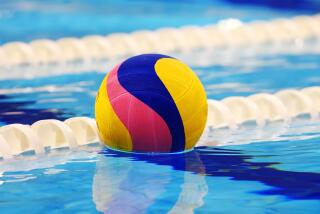U.S. (Polo) Open Plays the Desert : World’s Top Players Frolicking on 10 Fields of Eldorado
- Share via
INDIO — Lathered to a white sweat in the desert heat, three polo ponies stampede toward the ball, their riders swinging mallets menacingly. Through gritted teeth comes a low growl, “Noooo, leave it.”
Two horses collide, a mallet cracks a rider’s boot and another player swoops in, snatching the ball away.
This is serious horsing around.
In the unseemly environs of the desert, some of the world’s top polo players have converged on the Eldorado Polo Club, about 20 miles east of Palm Springs, for the U.S. Polo Open. Since last Wednesday, eight teams have been playing off for Sunday’s final.
It has been 21 years since the prestigious tournament has been held in California--and then it was played in Santa Barbara. So how did the new kid on the block, the 7-year-old Eldorado club, persuade the U.S. Polo Assn. to bring its headline act to the California desert?
“Eldorado is the largest club in the country,” said Eldorado spokesman Richard Foxx. “Santa Barbara only has three fields. We have 10.”
California knows that it will be judged by the ruling Eastern polo Establishment on everything from the condition of Eldorado’s Bermuda grass fields to the finesse of its players. Clearly the Open is the state’s chance to make its mark on U.S. polo.
Summerfield Johnston Jr., USPA president, acknowledges that California has become a force in polo.
“The growth of polo in California has been phenomenal,” he said from USPA headquarters in Lexington, Ky. “The extraordinary facilities of the Eldorado Polo Club are in peak condition to make this one of the most exciting Opens.”
Eldorado cannot, however, score points with its 100-degree weather. In a sport that often threatens horse and rider with dehydration--polo ponies are routinely given electrolytes and players chug Gatorade--the choice of a desert club for the toughest play of the season may seem to be tempting fate.
“Some players are showing a fatigue factor later in the game. They don’t realize they’re overheated because in this dry heat they don’t sweat as much,” said Corky Linfoot, who generally plays in the humidity of San Antonio, Tex.
The polo ponies--most of them sleek thoroughbreds--heat up quickly in play but actually cool faster afterward in the dry heat. Peter Baldwin, who plays in Maui, Hawaii, and Santa Barbara, says the key to desert play is switching horses during chukkers--polo’s 7 1/2-minute periods.
Baldwin, who brought a dozen ponies to the Open, is captain of the Maui team, which has been eliminated. He was on the sidelines, checking out the competition in a preliminary game and ruminating about the sport that has gripped him since he was 12.
“Polo is like playing chess on a raceway,” he said, his eyes fixed on two players in a hard ride-off for the ball. “It takes a lot of concentration and sheer guts. The game changes so quickly that you never know what’s going to . . . Look out! Move!”
He lunged forward, grabbed a spectator by the shoulders and pulled her off the sidelines, seconds before two galloping horses came crashing over the low sideboards.
“These guys will run you right over,” he said. “They don’t stop for anything. They don’t even see you when they’re chasing the ball.”
Such is the polo mind set. You ride hard, you play to win. With the top players from eight countries all determined to drink champagne from the silver winners’ bowl Sunday, play here has been fierce. After his team won a preliminary match, Glen Holden of Los Angeles held an impromptu strategy session on the sideline with Coach Robert Skene, who for 17 years was the world’s top-rated player.
Although Holden’s Gehache team won the 20-goal Pacific Coast Open this summer in Santa Barbara, Skene said the 26-goal U.S. Open will be “almost a different game” because of the speed.
The ratings of its individual players are combined for a team’s total, which in this tournament cannot exceed 26. That is twice the rating--and the speed--of most other USPA tournaments.
The big gun here is clearly Memo Gracida of Mexico. One of the few 10-goalers in the world, he has ridden for teams that won five U.S. Opens, the British Open, the Argentine Open and the World Cup.
Gracida is playing for the Aloha team with his brother, Carlos, also a 10-goaler, which makes him all the more formidable. “When I play with my brother, I believe I play two or three goals better than usual,” he says.
There is a strong contingent of 8-goal players in the Open, including Lionel Macaire of France, who is playing for Gehache. For many years a competitor in the Olympic equestrian sports of dressage, jumping and the three-day event, he has devoted himself to year-round polo on two continents since 1981.
“I love polo,” he said, dousing his head with water after a game. “I just love the game. If there was no polo, I would be very sad. I play three games a week all year, and I can’t stand to wait three days to the next game. In fact, I want to play right now.”
For other players, part of the allure of the game is its inherent danger. Seven-goaler Mike Conant, from a legendary California polo family, laughs about a bicycle polo game he saw on television.
“That’s not the thrill. The thrill is out there,” he said, pointing at the warfare on the field. “When you fall off a bicycle, that’s one thing. In polo, you have 1,000 pounds coming down on top of you. That’s when you know you’re not going to see daylight.”
More to Read
Go beyond the scoreboard
Get the latest on L.A.'s teams in the daily Sports Report newsletter.
You may occasionally receive promotional content from the Los Angeles Times.










